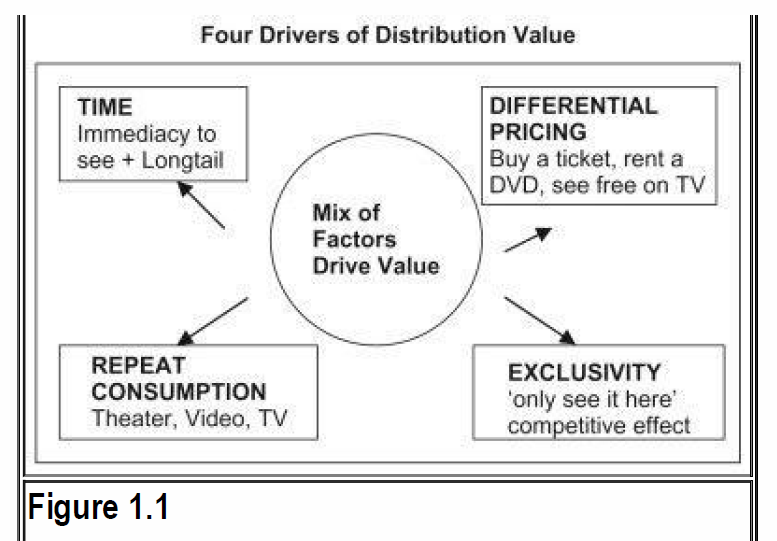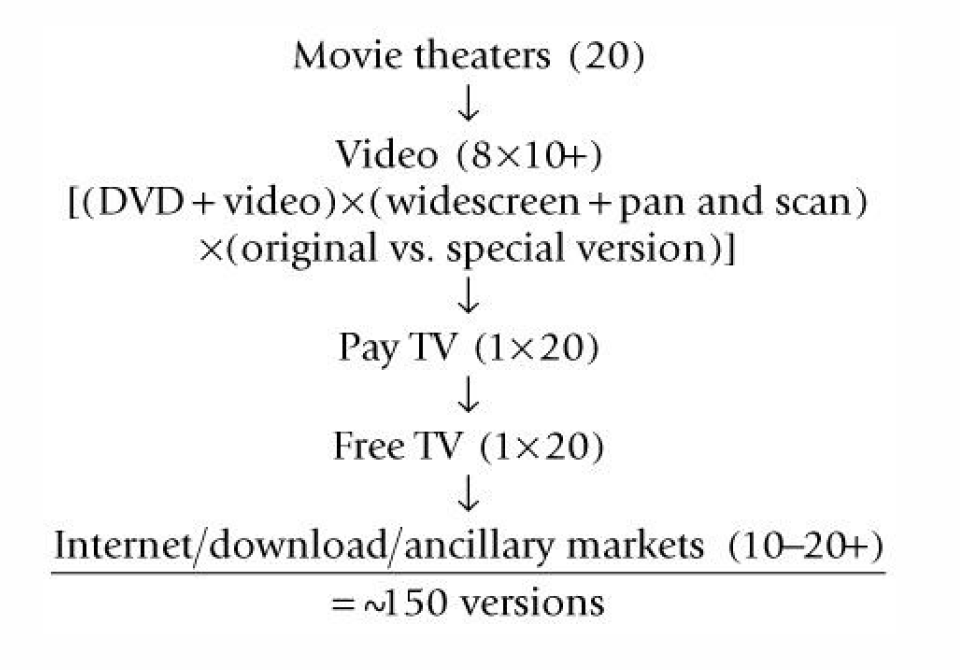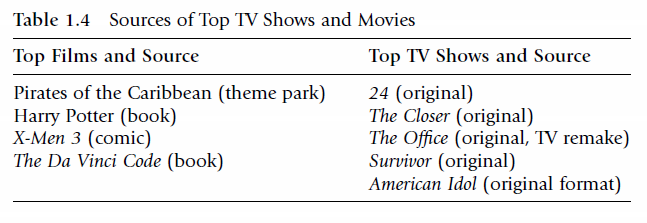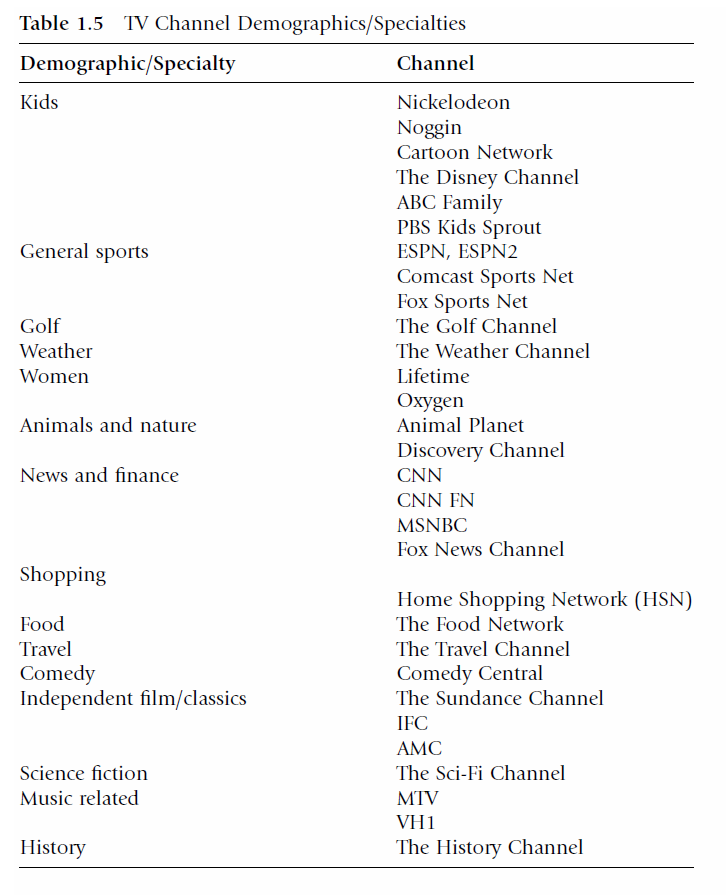Table of Contents
The Business Of Media Distribution
Cover Image
Praise page
Front Matter
Copyright
Dedication
Acknowledgment
- Chapter 1. Market Opportunity and Segmentation - The Diverse Role of Studios and Networks
- Chapter 2. Intellectual Property Assets Enabling Distribution - The Business of Creating, Marketing, and Protecting an Idea
- Chapter 3. Financing Production
- Chapter 4. Theatrical Distribution
- Chapter 5. The Home Video Business
- Chapter 6. Television Distribution
- Chapter 7. Internet Distribution, Downloads, and On-demand Streaming - A New Paradigm
- Chapter 8. Ancillary Revenues
- Chapter 9. Marketing
- Chapter 10. Making Money - Net Profits, Hollywood Accounting, and the Relative Simplicity of Online Revenue Sharing
References
Index
Chapter 1. Market Opportunity and Segmentation - The Diverse Role of Studios and Networks
Studios and networks
- Not a clear career paths . . .
:: Analysts seeking trends may promote “content is king,” but in the trenches success tends to be linked with marrying creative and sales skills.
- Importance of traditional media (film/TV/video) . . . .
:: Traditional media (film/TV/video) still accounts for over 90% of all media revenues and the success of online/digital ventures will be tied to how opportunities relate to existing revenue streams.
- Studios . . . .
:: studios are financing and distribution machines that bankroll production, and then dominate the distribution channels to market and release the films they finance. . . . Accordingly, the most defining element of a studio is its distribution arm ? ? ? this is how studios make most of their revenue, and is the unique facet that distinguishes a “studio” from a studio look-alike.
- Studios :: Sony, Disney, Paramount, Universal, Warner Bros., Fox, MGM
- Distribution power . . . .
:: what largely distinguishes a mini-major from simply being a large production company is its distribution capacity.
- Studios :: producing vs. financing and distribution
- Will not investing without (d ) (r ).
- Hiring stars, buying properties, financing films to make . . . . pretext to controlling (d ).
- Distrib vs. sales or marketing . . . . art of maximizing consumption and corresponding revenues . . . . marketing focuses on (a ) and (c ), distrib . . . . focuses on making (c ) (profitable). . . . art of creating REPEATING consumption of the same products.
:: Intellectual property rights are infinitely divisible, and distributing a film or TV show is the art of maximizing consumption and corresponding revenues across exploitation options. Whereas marketing focuses on awareness and driving consumption, distribution focuses on making that consumption profitable . Additionally, distribution is also the art of creating opportunities to drive repeat consumption of the same product.
- Products are distribution in multiple forms and formats, versions. There are consumer markets for each territory.
-
- Time
- Repeated Consumption (Platform)
- Exclusivity
- Differential Pricing
- (Film/TV/video markets) . . . Film is seen (consumed) in
- Movie theaters
- Video and DVD
- Paid television
- Pay-per-view television / VOD
- Free and cable television
- Hotel/Motel
- Airlines
- Non-theatrical (college, cruise ships, etc.)
- Internet / Portable devices
- Films is distrib. in a form of
- Film formats (35, 70, 160 mm)
- Digital mater for D-cinema
- Videocassette
- DVD
- Formatted for TV broadcast
- Compressed for internet / download
- Versions
- Original theater version
- Extended or special version for DVD / video
- Wide screen vs. pan and scan aspect ratio
- + Value added material → commentary, deleted scenes, trailers, etc.
- Sales in many markets and formats
- Overheads
- expenses and work-forces in various fields
- sales and geographically dispersed
- pipeline
- economics of scale . . . . sufficient quantity of products to sell
- <blockquote>Studio distribution is the organization and function that matches the content pipeline with the challenge of delivering that content to every consumer on the planet ? ? ? multiple times.</blockquote>
- CONTRILLING . . . .
- pos.
- neg.
- INDEPENDENTS . . . .
- Joint ventures due to . . . . rise of international markets
- by budget
- Low
- Under the Radar
- High
- Tent-pole
- Genre . . .
- action,
- romance,
- comedy,
- thriller,
- drama,
- historical or reality based stories,
- kids and family,
- musical,
- adult entertainment
- Other markets . . . video, online, and others such as books
- Brand creation, Brand extension
- From reality
- Books and comics
- Sequels
- Spin-offs
- Remakes
- Cross-oper sequels and spin-offs
- from Films to TV
- TV series to Films
- Game to Films
- Film life-cycle management
- Primary distrib
- Theatrical
- Video and DVD
- Pay TV
- Free TV
- Hotel/Motel
- Airline
- PPV / VOD
- Non-theatrical
- Cable and syndication
- Film revenue cycles . . .
- Theatrical → Hotel PPV → Home Video → Residential VOD → Pay TV → Free TV
- Television
- Television genres and time slots
- Range of Budgets
- Brand extension vs Brand spin-offs
- Television windows and life-cycle revenues
- Cable
- Syndication
- Video (by seasons)
- Download / Internet
- PPV / VOD
Chapter 2. Intellectual Property Assets Enabling Distribution - The Business of Creating, Marketing, and Protecting an Idea
Chapter 3. Financing Production
Overview
'Principal methods of financing films'- studio funding (financing)
- independent producer securing funds
- bank financing
- pre-sales,
- completion bonds
- negative pickup structures
- complicated debt and equity slate financing (such as building hedge fund)
- distribution rental (rent a distributor) model
- angel financing
- Principal methods of financing online production
- relationship between ABC/Disney and Stage 9 digital production –> sister division
- Such divisions recouped by revenues
- advertising
- sponsorship
- product placement
- a case of Kate Modern product :: MS, P&G, Neutrogena
- Video advertisement
- difference between traditional TV and online CPM
- TV :: live effects, mass accesses, unclear measurement
- online ::
Variety of Financing Methods as a Response to Difficulty and Risks in Predicting Success of Experienced Goods
- Experienced good?
- Public good?
- Risk management (system)
- Awards
- Critics
- Words of mouth
- Prediction :: no-prediction
- Formulae to manage the high risks :: Variety of financing methods
- Studio Financing
- Classic PFD deal
- PFD . . . .
- Producer “sets it up.” after . . . .
- copyright and underlying rights go where?
- Studio financing of production slate; studio co-production
- co-productions
- War of the World case
- talent vs. director
- selling off pieces (of rights)
- Fox vs. Paramount in Titanic case
- Paramount practice in 90s
- Debt and equity financing
- stocks / equity
- Dreamworks went public. . . .
- Off-balance sheet financing
- Disney's investment in . . . .
- Hedge fund and private equity investments
- cost share
- profit share
- pitfalls and strengths
- Wall Street Journal story . . . . New investor are often . . . .
- Inclusion and exclusion of property in Tentpoles in slates
- Independent Financing
- two aspects of IF
- Foreign pre-sales
- Ancillary advances
- Negative pickups
- Bank credit lines
- Mini-major Min-studio
- Angel investor
- Rent a Distib.
- case of Lucas film
- Pixar
- sticking to creativity and economy
- Television . . . . (not covered) . . . .
Chapter 4. Theatrical Distribution
Chapter 5. The Home Video Business
Chapter 6. Television Distribution
Chapter 7. Internet Distribution, Downloads, and On-demand Streaming - A New Paradigm
Chapter 8. Ancillary Revenues
Chapter 9. Marketing
Back to Experienced Goods
Strategy (Film)
- Budgets
- Media / Ad
- PR
- Web site
- Travel
- Word of Mouth Limited Opening
- Niche Marketing
- Timing, seasonality
- Internal factors
- External factors
- Events of national and international importance
- holidays
- competition
- economic events
- Third-party help
- Using star / talent :: good and bad
- e.g., Tom Cruse
- Promotional partners
- meaning of being (making) partners
- PPL :: pitfalls and strength
- Theatrical marketing budget
- MEDIA buys
- Allocation
- TV / Radio
- Print (newspaper)
- Outdoor
- Online
- Internet effects
- Relationships between budget and success
- Trailers
- two kinds of trailers . . . . Launch and teaser
- Posters
- In-theater
- Press and PR
- Using press kit and electronic press kit
- How and why
- Screenings
- Building and using Web sites
- interactivity
- Market Research
- Measurement of what ? established
- Third-party cost
- Net sum and rise in historical marketing costs
- Video marketing
- Press, PR, and thrid-party promotions
- Net Sum
- Television
. . . .






